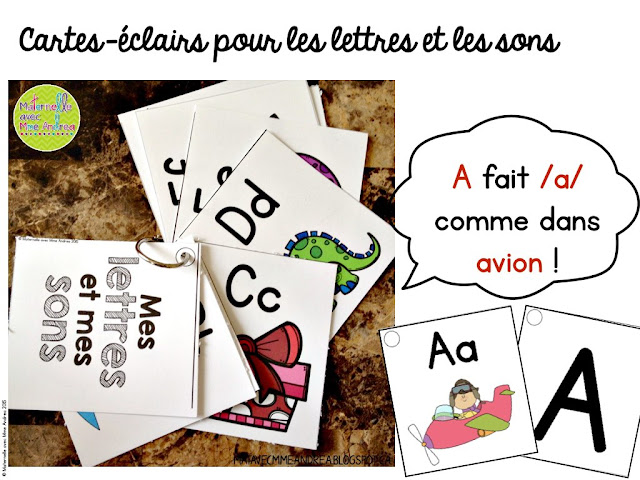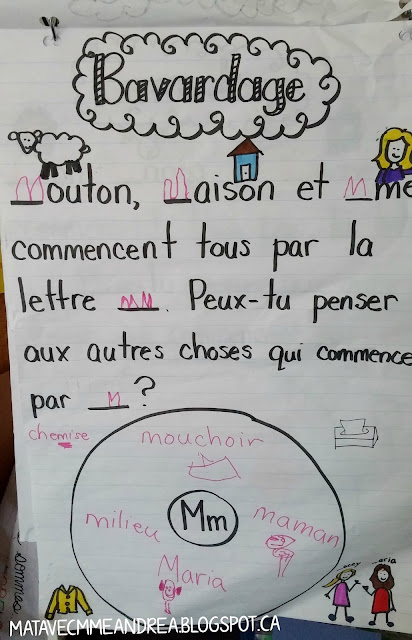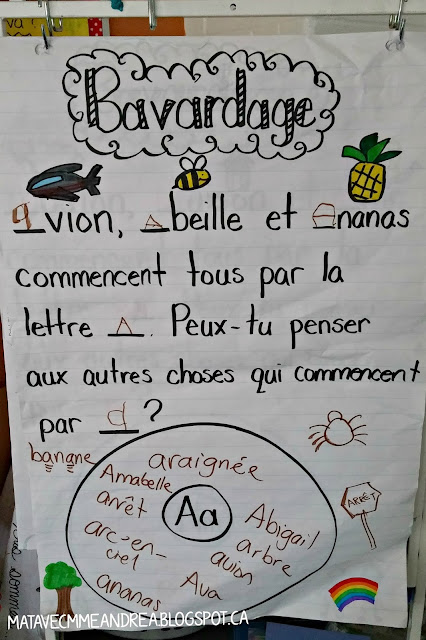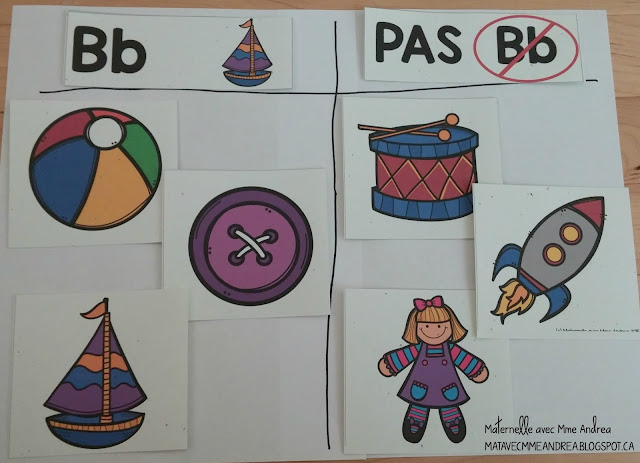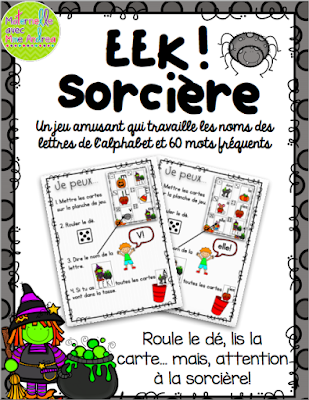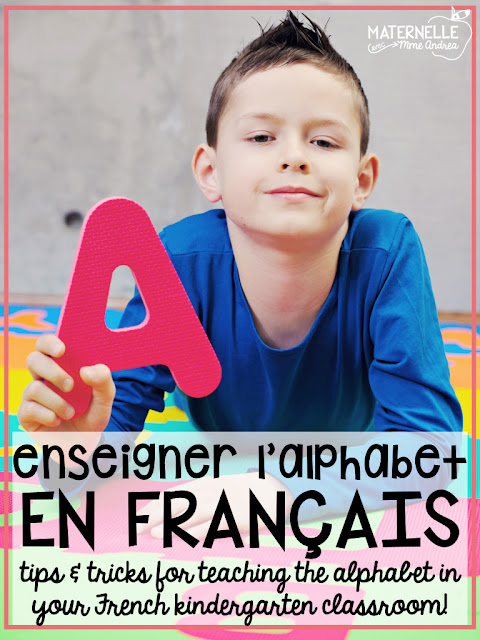Hi everyone!
I was reading a post on the awesome Facebook group Primary French Immersion Teachers this morning asking about how people teach letter names and sounds to their kindergarten students. I started to share some things that I do, and when my answer turned into a novel, I decided I should just write a blog post about it! :)
As mentioned in a previous post, I assess my students using ESGI Software. It is quick and easy (max 2 mins per student), and no, they are not paying me to say that, haha! I did a quick assessment during the first week of school to see if my students already knew their letters. And… nope! No one did. A few knew a bunch in English, which is lovely, but not overly helpful. One or two knew most of them, but most knew less than half.
But that is no problem! As a kindergarten teacher, it’s my job to teach them that! And honestly, it is even easier when you don’t have a handful of kids who already know them all, because then everyone can start at the same place. We are so not ready for small groups at the beginning of the year, so I like for my whole group instruction to be able reach as many students as possible.
Before I jump into the activities we do, I feel like I should mention that routine is KEY in my classroom. We have the same routine every day. We do the same general activities (with different letters of course) at the same time, Monday through Friday. It may sound boring to you or me, but the kids LOVE it. They love knowing what to expect, they love feeling like little pros, and I love how efficient and competent they become by the end of our alphabet unit compared to when they are just starting out!
First of all, I introduce one letter per day (four per week, and then a review game on Friday to practice all the letters we have seen so far). I start with long consonants first (like m, l, s, r, etc.), because they are the easiest to hear. It is SO important to me that my students are able to hear letter sounds. Especially if French is not their first language (despite teaching at a francophone school, we are in an English community). It takes a LOT of practice for them to be able to hear, produce, and identify sounds, and it is an essential skill for reading, writing, and speaking.
When I introduce each letter to my students, I also teach them a gesture to go with each sound. We use the same structure each time: “”a” fait /a/ comme dans avion.” When we make the letter sound, we do the gesture (moving our arms like an airplane, for example). After I introduce the letter, I give each child a flashcard to add to their letter ring that they review nightly for homework.
I only send letters home that we have already practiced – to me, homework should be about reviewing and consolidating what they have seen at school, and not a time to learn new things.
Our flashcards look like this:
I use the ones with the images, but the pack includes uppercase and lowercase letters alone as well. My students open the rings and add their cards themselves each morning during our morning meeting. If they can’t do it, they ask a friend for help. Their cards stay in their reading bags and they can also review them during read-to-self if they so choose.
At the end of the first week, they only had four letters, but now we are finishing up week five and will be up to 20! These cards are available HERE in my TPT store, and also come with posters and personal word wall sheets, all with the same images.
Consistency is key! :)
After sorting out our agendas and our flashcards, we start each day with a morning alphabet message.
Depending on how organized I am, sometimes (ideally) it looks like this:
We read together, they fill in the blanks to make it make sense, and then they came up with some things that start with Mm to go into our circle map. This was one of our first days, so they drew and I wrote. I also add clues to the outside in case they are stumped for ideas.
Sometimes they have so many ideas that we don’t have time to draw them all and I write frantically as their ideas just explode out of them ;)
Also, sometimes life happens, and our morning message looks like this:
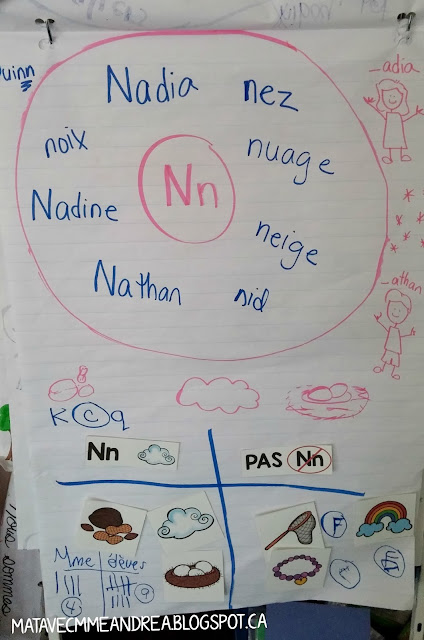 |
| Ignore the bottom part for now, that’s coming! |
#reallife.
It should be noted that I am not an artist, haha.
After we have talked about what things start with our letter of the day, we play a sorting game. We play this game every day, and every morning, I have kids arriving saying “do you think you are going to win today, Mme?! You aren’t!”
They seriously love it.
I have six images in a baggie – three that start with the target letter and three that don’t. Since my students are all over the map as far as vocabulary goes, I pick a mix of simple words for my French newbies, and words that will probably be new to everyone. We review them all together before we get started. I structure this game as “Mme Andrea vs. the students.”
After we have reviewed the words together, they don’t make a sound ;) Every time someone shouts out the answer, is silly, talks to their neighbour, etc. – I get a point! Every time someone comes up and correctly sorts a card, they get a point. They get unlimited tries to get it right and I am right there beside them saying “nnnnnnnnnn, nnnnnnoix… does that sound like nnnnnnnn?” and making the gestures for each word’s beginning sound so… they are pretty successful. To be honest, I have never won, ha! We are into some pretty tricky letters now (we did Y yesterday), so I keep telling them that I am going to win, but… it hasn’t happened yet!
They have a lot more stamina for sitting at the carpet and know a lot more letter sounds now than they did in the beginning, so I have added another level to the game where I also ask them to come up and write the actual beginning sound for the pictures that don’t start with our letter of the day. Here is a closer look at what the whole group sort looks like:
After the whole group sort, they do their own! I cover up our sort to encourage them to say the word and think about the beginning sound on their own. They can then go self-check their answers against our sort after. When we are finished, they glue their page into their notebook.
I don’t require them to colour, but they can if they want to when they are finished gluing – if there is still time left. What I am really looking to get out of the activity is for them to practice listening for beginning sounds. I am not all that concerned about the colouring at the moment. We have a lot to get done in a day, so usually I give 7-10 mins to finish their sorts, and they have no problem getting them done in that time :) Some are so efficient now that it only takes them 3 minutes – crazy!
To grab the whole group and individual sorts, as well as the list of gestures I use, just click HERE to be taken to my TPT store. There are over five weeks worth of sorts if you do a letter a day!
On Fridays, we learn a new review game that practices all the letters we have learned. So far, we have learned EEK!, Pomme, pomme, petite et ronde, and Roule et couvre – which is our favourite so far! I like partner games best for our review time, because every child gets the chance to talk, but I LOVE “Pomme, pomme” for transition times – when some of my students are finished an activity and we are waiting for others to clean up and get to the carpet, for example.
Next week, we will be playing EEK – Sorcière! I am so ready for Halloween haha, and to them, new clipart makes it like a whole new game! A whole new game that I don’t have to teach them, because they already know how to play ;)
We have learned 6 new sight words as well, so I can toss those cards in there too.
Please note that I only put in cards for letters and words that we have already learned :)
Soon, all of our review games will become choices for independent centres. Some of them already are.
I always have our laminated Play Doh mats (with Play Doh, beans, white board markers, etc.) as an early-finisher option to review letter formation throughout the day as well. In the afternoons, when our brains are pretty tired or fried, we do our directed draws and letter formation practice.
I photocopy the directed draw for the letter on one side, and a tracing sheet for the letter on the other. I give them markers for tracing and they are as happy as clams! Before I show them how to do the directed draw and the correct letter formation, we review our letter sounds and gestures one more time.
The tracing sheets I use I got HERE, from La classe de Madame Angel. They are a good size for those kindergarten fine motor abilities! You can click on the pictures below to find my Play Doh mats and directed drawing resources.
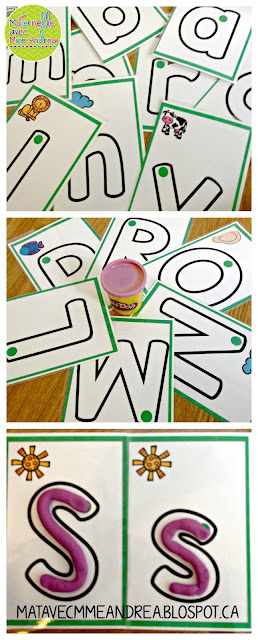 |
| Click here to see my Play Doh mats |
 |
| And here for my directed draws |
That’s about it! Once we get all the way through the alphabet, we’ll get into the real nitty gritty of rhyming, syllables, blending, segmenting, ending sounds, vowel sounds, etc. I find that by concentrating so much on listening for sounds from the very beginning of the year, it REALLY helps them know how to listen for more complex sounds later, and to be able to play with sounds in words.
Once we wrap up our first run through the alphabet in two weeks, I will re-evaluate who knows which letter sounds, and be able to create my first small groups based on who needs more time and practice, and who is ready to start putting sounds together.
So exciting!!
I am definitely still learning as I go along, but I hope that my post about alphabet instruction was helpful to you!
Let me know in the comments if you have any questions :)



